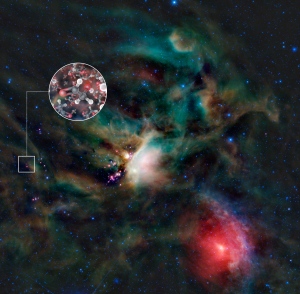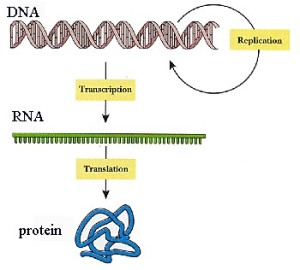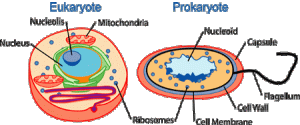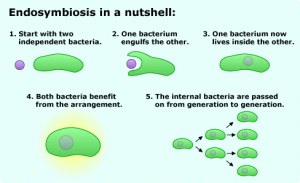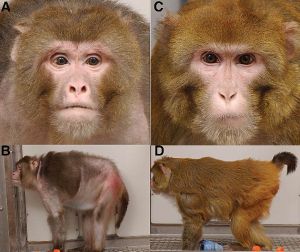What is Ketosis?
Many people are confused about the idea of ketosis and ketogenic diets. Thanks to advice from uninformed medical professionals, this metabolic state is sometimes even viewed as being unhealthy. But, nothing could be further from the truth!
When you are burning sugar/glucose rather than fat for energy, your body is relying on sugar for fuel. When burning fats for fuel, either body fat or fats consumed in your diet, you are in a state of ketosis and you are producing and burning ketones. That’s it! That is all that ketosis means. It bears repeating that the fat you use for fuel can come either from the food you consume or the body fat you carry around with you. When we breakdown fat as a fuel source it gets converted by our mitochondria into usable energy (ATP), just like blood glucose.
As a result of confusion surrounding the science of nutrition; largely as a result of a crippling level of special (often financial) interests, people often view ketosis and dietary fat as dangerous. But, fat is actually the body’s preferred source of fuel.
When people eat reduced levels of carbohydrates, (excluding some forms of fibre), they begin to burn fat for energy. As we start to burn more body fat, ketone levels rise since they are a by-product of fat metabolism. Importantly, some of those ketones are actually a preferred source of energy for specific organs. Two examples are acetoacetate and beta-hydroxybutyrate. They are the go-to energy source for heart muscle and kidney tissue. Yes, you read that correctly! Fat, (via the process of ketosis), is actually good for your heart and your kidneys. In fact, most of our cells, with a special focus on the brain, easily switch to using ketones as well as fats as an energy source.
Some people think that ketosis is “bad” largely because of confusion about two important terms. This includes many medical doctors. They are confusing two states or processes. They are diabetic “ketoacidosis (DKA)” and nutritional ketosis or “keto-adaptation”. Understanding this difference requires an explanation of what ketones are. Then it is possible to differentiate between these two processes and understand their impacts on nutrition.

A “ketone” is a chemical structure in which oxygen is double-bonded to carbon sandwiched between at least 2 other carbons. The body can produce, from fat and some amino acids, three different types of ketones.
Why do we make ketones at all if we can simply rely on blood sugar? Well, for starters the burning of sugars is a short term solution. It serves an important purpose by supplying energy for relatively short periods. It is quickly consumed. However, there have been many times in history where carbohydrate-based foods would have been non-existent as an energy source. These include ice-ages and periods of catastrophic and unpredictable weather change. If we had relied exclusively on carbohydrate and plant-based diets during these times, we would have starved to death quickly. Compounding this problem is the fact that there is no way to store glucose internally for any decent length of time. With no alternate, longer lasting, process for creating energy, life in general would never have survived. Ketones are an evolutionary solution to that need. They are a part of a process of burning fats for energy instead of burning sugars.

The burning of fats and ketones is a huge evolutionary advantage for air breathers. In the beginning, the simple, non DNA-storing, life of prokaryotic cells did not require oxygen because sugar/glucose based energy production was based on anaerobic processes. No oxygen was needed. In fact, there was no oxygen in the atmosphere at all. As it became available, life developed aerobic processes as second way of generating energy to live. We learned to burn both externally sourced fats and internally stored body fat for fuel.
We can’t store much more than a day’s worth of glucose at any time. If we couldn’t burn fat for energy, either externally sourced fats and or our own body fats, we would literally die within hours. Think of glucose as kindling for the anaerobic fire. It is easily burned but it only lasts for a short time. Without the aerobic ability to consume fats, either from external or internal sources, we could not have survived the famines and extreme shortages of food we have faced throughout most of our history. Fats offer a storable, easily consumable, portable, and long lasting source of energy.
The liver takes fat and the amino acids leucine and lysine and converts them into ketones. Consider the example of your brain. It functions by burning both glucose and ketones as fuel. Because of environmental pressures, the brain has developed an affinity for ketones. That is because dietary fat and stored body fat are reliable resources that do not really have an “off season”. They are always around while carbohydrates are generally seasonal. Interestingly enough, the time that most carbs are harvested in is in a single season. In North America, harvest season is in autumn. The insulin that is promoted by dietary carbohydrate intake, when combined with sufficient dietary fat, leads to stored body fat to keep us alive through the winter months when no source of carbohydrate would be around.

Think of the ice age. We likely would never have had an appreciable supply of carbohydrates. Fat consumption would have been a life saver – literally! Similar conditions applied to Inuit populations until very recent times. The traditional Inuit people of the arctic were documented to have incredibly low rates of both heart disease and cancer. These examples illustrate the fact that there are no essential carbohydrate requirements for humans. There were long stretches in history where they were not available.
Now that we have a better understanding of ketosis, we can ask “What is ketoacidosis and why is it unhealthy?”
Consider what happens when diabetics cannot receive sufficient insulin. They go into a state of starvation. This generally happens in type 1 diabetics, who cannot make insulin at all. Some type 2 diabetics who can generate insulin but supplement with insulin injections can also have this as an issue when they are reducing their dosages or develop poor sensitivity to the drug. The lack of insulin in type 1 diabetics leaves them with plenty of blood sugar. But, with no insulin available, blood glucose can’t be utilized at the cellular level. In a situation like this, their body does what anyone’s else’s would. It starts consuming body fat for energy. So, though these metabolic states look somewhat similar they are not even close to having the same causes. With no insulin and the perception of starvation, there is no negative feedback to stop the breakdown of fat and the cycle continues. As the associated ketone levels (specifically, beta-hydroxybutyrate) approach the 15 to 25 mm mark, the resulting pH imbalance leads to profound metabolic derangement. The patient becomes critically ill and can even die.
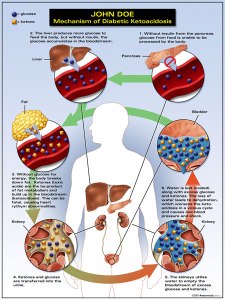
However, if you are not a type one diabetic, your body is able to make insulin. You will not go into diabetic ketoacidosis. If it is required, you can make blood sugar internally through gluconeogenesis. If insulin is present, and assuming that the body is able to use it, the required glucose will be transported into cells. You will not repeat the cycle leading to ketoacidosis.
Ketosis is nothing to worry about in people with normal metabolisms. In fact there are some major potential benefits from being in ketosis. One of these benefits derives from the fact that cancers can only be fuelled by glucose.
Ketogenic Diets and Cancer
According to Dr. Thomas Seyfried, author of Cancer as a Metabolic Disease, “We’re not going to make major advances in the management of cancer until it becomes recognized as a metabolic disease.”
 Regulating your blood-glucose leptin and insulin levels through diet, exercise, and stress management, may be one of the most critical aspects to an effective cancer recovery program. These factors are also potentially vital in preventing cancer from ever developing in the first place. Way back in 1931, the Nobel Prize was awarded to German scientist and researcher Dr. Otto Warburg for discovering that cancer cells have a deeply different energy metabolism when compared to healthy cells. He found that malignant tumours survive by using sugar for energy. As an example, recent research has determined that although cancer cells feed on both glucose and fructose, pancreatic tumour cells use fructose in particular to divide and spread throughout the body.
Regulating your blood-glucose leptin and insulin levels through diet, exercise, and stress management, may be one of the most critical aspects to an effective cancer recovery program. These factors are also potentially vital in preventing cancer from ever developing in the first place. Way back in 1931, the Nobel Prize was awarded to German scientist and researcher Dr. Otto Warburg for discovering that cancer cells have a deeply different energy metabolism when compared to healthy cells. He found that malignant tumours survive by using sugar for energy. As an example, recent research has determined that although cancer cells feed on both glucose and fructose, pancreatic tumour cells use fructose in particular to divide and spread throughout the body.
According to Dr. Seyfried if you restrict sugar and provide an alternate fuel, specifically fat, you can considerably reduce the rate of growth of cancer. He explains:
“When we’re dealing with glucose and [cancer] management, we know from a large number of studies that if respiration of the tumour is ineffective, in order to survive, the cells must use an alternative source of energy, which is fermentation. We know that glucose is the primary fuel for fermentation. Fermentation becomes a primary energy-generating process in the tumour cell. By targeting the fuel for that process, we then have the capability of potentially managing the disease.”
The method that Dr. Seyfried suggests is a low-carb, low to moderate protein, high-fat diet. It will effectively lower your blood sugar (glucose levels) and leave you with energy derived from ketosis. It is a measurable process that you can monitor using a blood glucose meter. This is a ketogenic diet that will also raise ketones in the body. As we have already discussed, fat is converted to ketones that your body can burn in the absence of glucose. When combined with protein restriction, these steps put your body in a metabolic state that is hostile for cancer cells.
“[A ketone] is a fat breakdown product that can replace glucose as a major fuel for many of the organs and especially our brain,” says Dr. Seyfried. Tumour cells, however, cannot use ketone bodies because their metabolism won’t allow it. So a ketogenic diet characterizes a way to focus on and marginalize tumour cells. It also allows you to dramatically lower your glucose levels, as the ketones will protect your body against any hypoglycemia that might otherwise be induced by heavy carb restriction.”
In closing, a final statement from Dr. Seyfried:
“All of the newer cells in your body will be transitioned to these effective ketones, thereby protecting them from damage from hypoglycemia. At the same time, the tumour cells are now marginalized and under tremendous metabolic stress. It’s a whole body therapy—you need to bring the whole body into this metabolic state,” he explains.
“We like to call it a new state of metabolic homeostasis: a state where ketones have reached the steady state level in your blood and glucose has reached a steady lower level in your blood… If it’s done right and implemented right, it has powerful therapeutic benefits on the majority of people who suffer from various kinds of cancers. Because all cancers have primarily the same metabolic defect.”

